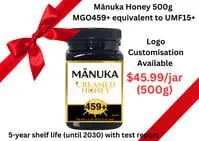The Wellness Power of Premium Mānuka Honey
BY KAREN LO, MANAGING DIRECTOR, ARISTA FOODS LTD
Did you know it takes 12 bees their entire lifetimes, flying nearly 3,000 miles, to make just one tablespoon of honey? Every drop is a miracle of nature, and Mānuka honey is especially treasured for its rare compounds and healing potential.
When selecting premium Mānuka honey, always look for UMF (Unique Mānuka Factor) certification, which guarantees authenticity and potency. Monofloral Mānuka honey, sourced mainly from the Mānuka flower, carries stronger antibacterial benefits and a higher price. Multifloral blends are more affordable but contain lower concentrations of active compounds.
[insert Diagram: UMF Grades – from 5+ for daily wellness to 33+ for intensive use]
You might wonder: why is honey sweet, isn’t that bad for me? Unlike refined sugar, Mānuka honey’s sweetness comes with over 2,300 natural compounds, including enzymes and antioxidants. When produced using gentle warming and thermalisation methods, like Arista’s, these nutrients remain intact.
Some people feel a tingling or sore sensation in the throat after taking Mānuka honey. This is a natural response to its antibacterial and enzyme activity at work.
For the best results, enjoy honey on an empty stomach first thing in the morning, within an hour after lunch, and again before bed. Increase intake, one to two teaspoons, two to three times daily, when feeling unwell. Always use non-metal spoons to avoid oxidation, and store honey away from heat and sunlight at a stable 16–20°C.
Important to note: honey should never be given to infants under 12 months, and those with severe allergies to bee products should avoid it.
Mānuka honey is not just food, it is nature’s gift for wellness, carefully crafted by bees and valued for centuries for its healing properties.


28
